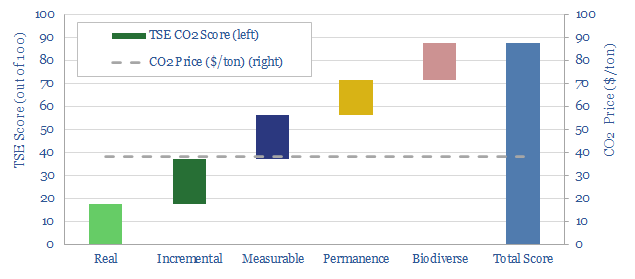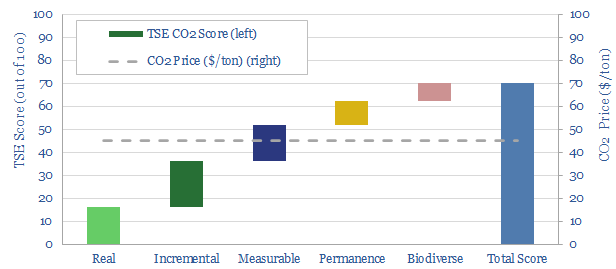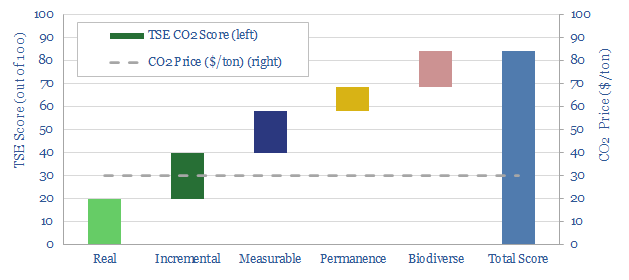CO2 Removals
-
Nature-based CO2 removals: a summary?

This data-file aggregates the details of different nature-based CO2 removals projects that we have been supporting at Thunder Said Energy. The average nature-based reforestation initiative that we supported in 2022 scored 70/100 on our framework. Statistical details and distributions are explored.
-
CO2 removals: CO2OL Panama project?

The CO2OL Tropical Mix project has planted 9M trees on 13,000 hectares of degraded pasture land across 45 sites in Panama since 1995. 20-30% of the land is reserved for conservation. The project achieved a relatively high score of 88/100 on our usual assessment framework. CO2 credits are priced at $38/ton. We contributed $1,900 to…
-
CO2 offsets: Pachama’s AI platform?
Pachama is a nature-based technology company, which has raised $79M, to create a portal where buyers can choose “from rigorously vetted forest restoration and conservation projects”, which in turn are tracked using proprietary AI. This data-file evaluates Pachama’s portfolio and our own experiences, using our usual framework for assessing nature-based CO2 removals.
-
CO2 removals: teak plantations, Nicaragua?
We reviewed a reforestation initiative, which should absorb 100,000 tons of CO2 from the atmosphere, by row-planting teak on former pasture land in Nicaragua. The project scores 70/100 on our five-point framework. But it also illustrates key debates for nature-based CO2 removals.
-
CO2 removals: TIST, Kenya and Uganda?
TIST is a non-profit, founded in 1999, coordinating the efforts of 137,000 subsistence farmers, mainly in Kenya and Uganda, to plant over 23.6M trees. CO2 credits are VERRA certified and scored highly on our framework for assessing nature-based CO2 removals.
-
CO2 removals: Eden Reforestation, Madagascar?
Eden Reforestation is a non-profit aiming to counteract deforestation and extreme poverty. It has planted c1bn trees and provides a fair income to c15,000 people. We appraised its activities in Madagascar on our CO2 removals framework, and made a $1,500 donation.
-
Carbon offsets: cost of CO2 removal per tree planted?
What is the cost of CO2 removal by planting trees? This calculator assesses different types of trees, types of planting, survival, permanence and discounting. A good ballpark range is $15-30/ton. Verified CO2 removals are likely higher cost but higher quality offsets.
-
CO2 Removals: BaumInvest Mixed Reforestation, Costa Rica?
We have reviewed the BaumInvest Mixed Reforestation Project in Costa Rica, on a framework for de-risking nature-based CO2 removals. As a result, we have purchased 67 tons of CO2 removals from the project, at $45/ton, for a total of $3,015 in July-2022.
-
Carbon offsets: costs and leading companies?
This data-file screens 30 companies that are offering CO2 offsets to consumers and commercial customers. Costs vary from $4-40/ton, as a function of project types and organizational structure. We recently used the data-file to offset 200T of CO2, in the most economical, tax-efficient and personally resonant way.
Content by Category
- Batteries (89)
- Biofuels (44)
- Carbon Intensity (49)
- CCS (63)
- CO2 Removals (9)
- Coal (38)
- Company Diligence (95)
- Data Models (840)
- Decarbonization (160)
- Demand (110)
- Digital (60)
- Downstream (44)
- Economic Model (205)
- Energy Efficiency (75)
- Hydrogen (63)
- Industry Data (279)
- LNG (48)
- Materials (82)
- Metals (80)
- Midstream (43)
- Natural Gas (149)
- Nature (76)
- Nuclear (23)
- Oil (164)
- Patents (38)
- Plastics (44)
- Power Grids (130)
- Renewables (149)
- Screen (117)
- Semiconductors (32)
- Shale (51)
- Solar (68)
- Supply-Demand (45)
- Vehicles (90)
- Wind (44)
- Written Research (354)






